40 chemical equation label
The Chemical Equation - Introductory Chemistry - 1st Canadian Edition Many chemical equations also include phase labels for the substances: (s) for solid, (ℓ) for liquid, (g) for gas, and (aq) for aqueous (i.e., dissolved in water). Special conditions, such as temperature, may also be listed above the arrow. For example: 2NaHCO 3 (s) → 200°C Na 2 CO 3 (s) + CO 2 (g) + H 2 O (ℓ) Key Takeaways Chemical reaction and equation - Study Innovations A chemical equation is a symbolic representation of an actual chemical change. or The short-hand method of representing a chemical reaction in terms of symbols and formulae of the different reactants and products is called a chemical equation. A chemical reaction can be represented in two different ways : 3.1 STEPS FOR WRITING A CHEMICAL EQUATION
How to Write a Chemical Equation (with Pictures) - wikiHow In chemistry terms the equation is the recipe, the ingredients are "reactants," and the cookies are "products." All chemical equations look something like "A + B →C (+ D...)," in which each letter variable is an element or a molecule (a collection of atoms held together by chemical bonds). The arrow represents the reaction or change taking place.
Chemical equation label
What are Chemical Equations? Detailed Explanation, Examples - BYJUS Chemical Equation: CaCl 2 + 2AgNO 3 → Ca (NO 3) 2 + 2AgCl↓ Ionic Equation: Ca 2+ + 2Cl - + 2Ag + + 2NO 3- → Ca 2+ + 2NO 3- + 2AgCl↓ Comparing the reactants and the products of the ionic equation and the chemical equation, it can be observed that the Ca 2+ ( calcium ion) and the NO 3- (nitrate) ions are present on both sides of the ionic equation. Write a chemical equation for cellular respiration. Label the molecules ... A sequence of chemical processes known as cellular respiration convert glucose into ATP, which can then be used as energy for a variety of bodily functions.. What is cellular respiration? Glycolysis, the citric acid cycle, and oxidative phosphorylation are the three basic processes that take place during cellular respiration.The citric acid cycle happens in the mitochondrial matrix, oxidative ... 7.3: Chemical Equations - Chemistry LibreTexts Use the common symbols, (s), (l), (g), (aq), and → appropriately when writing a chemical reaction. In a chemical change, new substances are formed. In order for this to occur, the chemical bonds of the substances break, and the atoms that compose them separate and rearrange themselves into new substances with new chemical bonds.
Chemical equation label. What are the Parts of a Chemical Equation? | Life Persona The steps followed to write a chemical equation are: - Reagents and reaction products are identified and noted. - The formula or symbols of the reagents are written on the left side with a '+' sign between them. - The formula (s) of the products are written on the right side with a '+' sign between them. Solved Label the components of a chemical equation. Label | Chegg.com Label the components of a chemical equation. This problem has been solved! You'll get a detailed solution from a subject matter expert that helps you learn core concepts. See Answer Show transcribed image text Expert Answer Transcribed image text: Label the components of a chemical equation. Label the components of a chemical equation. Chemical Equations Flashcards | Quizlet Chemical Equation symbolic representation of a chemical reaction, will show the same # of each type of atom on each side of the equation. ex. Na + Cl2 -> NaCl Chemical Formula symbolic representation of of an element or compound. ex. NaCl (table salt) Chemical Reaction process in which bonds between atoms are broken and new bonds are formed. CH3(CH2)2CH3 + O2 = CO2 + H2O - Chemical Equation Balancer Label each compound (reactant or product) in the equation with a variable to represent the unknown coefficients. a CH 3 (CH 2) 2 CH 3 + b O 2 = c CO 2 + d H 2 O. Create a System of Equations. Create an equation for each element (C, H, O) where each term represents the number of atoms of the element in each reactant or product.
Chemical Equation | Reactants And Products In Chemical Reactions - BYJUS Chemical Equation | Reactants And Products In Chemical Reactions Understand the concept of balancing chemical Equation | Law of conservation of mass, reactants and Products | Why is it important to balance a chemical equation,balanced chemical equation for magnesium oxide. Login Study Materials NCERT Solutions NCERT Solutions For Class 12 Writing and Balancing Chemical Equations | Chemistry for Majors 4 × 1 = 4. 2 × 2 = 4. 4 = 4, yes. O. 2 × 2 = 4. (1 × 2) + (2 × 1) = 4. 4 = 4, yes. A balanced chemical equation often may be derived from a qualitative description of some chemical reaction by a fairly simple approach known as balancing by inspection. Consider as an example the decomposition of water to yield molecular hydrogen and oxygen. KClO3 = KCl + O2 - Chemical Equation Balancer Label each compound (reactant or product) in the equation with a variable to represent the unknown coefficients. a KClO 3 = b KCl + c O 2. Create a System of Equations. Create an equation for each element (K, Cl, O) where each term represents the number of atoms of the element in each reactant or product. K: 1 a = 1 b + 0c Cl: 1 a = 1 b + 0c O ... C6H12O6 + O2 = CO2 + H2O - Chemical Equation Balancer Label each compound (reactant or product) in the equation with a variable to represent the unknown coefficients. a C 6 H 12 O 6 + b O 2 = c CO 2 + d H 2 O. Create a System of Equations. Create an equation for each element (C, H, O) where each term represents the number of atoms of the element in each reactant or product.
How to write a chemical formula? - TeX - Stack Exchange In order to produce the following output involving a chemical formula. I can attempt to write the chemical formula as a mathematical formula: \documentclass {report} \usepackage {amsmath} \begin {document} As the scintillator $\text {PbWO}_ {\text {4}}$ crystals are used. \end {document} However, this method is a brute force when approaching a ... Chemical Equations - Definition, Representation, Types In an equation, the products are always written on the right side, with a plus symbol (+) between them. Between the reactants and the products, an arrow sign (→) pointing to the right is placed. This arrow indicates that the substances on the left-hand side of the equation are combined to produce the substances on the right-hand side. KOH + H3PO4 = K3PO4 + H2O - Chemical Equation Balancer Label each compound (reactant or product) in the equation with a variable to represent the unknown coefficients. a KOH + b H 3 PO 4 = c K 3 PO 4 + d H 2 O. Create a System of Equations. Create an equation for each element (K, O, H, P) where each term represents the number of atoms of the element in each reactant or product. Writing and Balancing Chemical Equations - Course Hero 4 = 4, yes. O. 2 × 2 = 4. (1 × 2) + (2 × 1) = 4. 4 = 4, yes. A balanced chemical equation often may be derived from a qualitative description of some chemical reaction by a fairly simple approach known as balancing by inspection. Consider as an example the decomposition of water to yield molecular hydrogen and oxygen.
What is the chemical equation for cellular respiration? The overall (unbalanced) chemical equation for cellular respiration is: "C"_6"H"_12"O"_6 + "O"_2 → "CO"_2 + "H"_2"O" + "energy" > The balanced equation is "C"_6"H"_12"O"_6 + "6O"_2 → "6CO"_2 + "6H"_2"O" + "energy" The equation expressed in words would be: "glucose + oxygen → carbon dioxide + water + energy" The equation is formulated by combining the three following processes into one ...
K + H2O = KOH + H2 - Chemical Equation Balancer Label each compound (reactant or product) in the equation with a variable to represent the unknown coefficients. a K + b H 2 O = c KOH + d H 2. Create a System of Equations. Create an equation for each element (K, H, O) where each term represents the number of atoms of the element in each reactant or product.
What is a Chemical Equation? - Definition & Examples Chemical Equations Chemical equations tell us the elements and/or compounds that are reacting and what the product (s) of the reaction. The coefficients on the substances in the reaction...
Al + HCl = AlCl3 + H2 - Chemical Equation Balancer Label each compound (reactant or product) in the equation with a variable to represent the unknown coefficients. a Al + b HCl = c AlCl 3 + d H 2. Create a System of Equations. Create an equation for each element (Al, H, Cl) where each term represents the number of atoms of the element in each reactant or product.
Laebling A Chemical Equation Part I - YouTube Labeling chemical equations and identifing reactants, yield and products.
3.10: Writing and Balancing Chemical Equations The initial (unbalanced) equation is as follows: Ca 5(PO 4) 3(OH)(s) + H 3PO 4(aq) + H 2O ( l) → Ca(H 2PO 4) 2 ⋅ H 2O ( s) 1. B Identify the most complex substance. We start by assuming that only one molecule or formula unit of the most complex substance, Ca 5(PO 4) 3(OH), appears in the balanced chemical equation. 2. Adjust the coefficients.
Chemical Nomenclature and Chemical Formulas - Owlcation A chemical formula indicates the relative number of atoms of each element in a substance. It consists of symbols of elements and subscripts which give the number of atoms of each element. Examples: The formula of water is H2O There are 2 atoms of Hydrogen and 1 atom of oxygen The formula of glucose is C6H12O6
Chemical Equation Balancer Simple chemical equations can be balanced by inspection, that is, by trial and error. Generally, it is best to balance the most complicated molecule first. Hydrogen and oxygen are usually balanced last. Na + O 2 = Na 2 O In order for this equation to be balanced, there must be an equal amount of Na on the left hand side as on the right hand side.
P2O5 + H2O = H3PO4 - Chemical Equation Balancer Label each compound (reactant or product) in the equation with a variable to represent the unknown coefficients. a P 2 O 5 + b H 2 O = c H 3 PO 4. Create a System of Equations. Create an equation for each element (P, O, H) where each term represents the number of atoms of the element in each reactant or product. P: 2 a + 0b = 1 c O: 5 a + 1 b ...
Label the chemical Equation - Liveworksheets Label the chemical Equation worksheet Live worksheets > English Label the chemical Equation Label the parts of the chemical Equation ID: 1570824 Language: English School subject: Science Grade/level: 5 Age: 7-9 Main content: Chemical Equation Other contents: NA Add to my workbooks (0) Download file pdf Embed in my website or blog
Symbols used in Chemical Equations Flashcards | Quizlet used for reversible reactions. +. used to separate two reactants or two products. ∆ (over the reaction arrow), indicates the application of heat to the reactants. ↓. indicates a precipitate formed by a reaction. (aq) designates an aqueous solution; the substance is dissolved H₂O; placed after the chemical formula.
What Are Chemical Equations? - ThoughtCo It's common to indicate the state of matter in a chemical equation by including parentheses and an abbreviation right after a chemical formula. This can be seen in the following equation: 2 H 2 (g) + O 2 (g) → 2 H 2 O (l) Hydrogen and oxygen are indicated by (g), which means they are gases. Water is marked (l), which means it is a liquid.
Andrew File System Retirement - Technology at MSU Andrew File System (AFS) ended service on January 1, 2021. AFS was a file system and sharing platform that allowed users to access and distribute stored content. AFS was available at afs.msu.edu an…
Examples of Balanced Chemical Equations - ThoughtCo 6 CO 2 + 6 H 2 O → C 6 H 12 O 6 + 6 O 2 (balanced equation for photosynthesis) 6 carbon dioxide + 6 water yields 1 glucose + 6 oxygen 2 AgI + Na 2 S → Ag 2 S + 2 NaI 2 silver iodide + 1 sodium sulfide yields 1 silver sulfide + 2 sodium iodide Ba 3 N 2 + 6 H 2 O → 3 Ba (OH) 2 + 2 NH 3 3 CaCl 2 + 2 Na 3 PO 4 → Ca 3 (PO 4) 2 + 6 NaCl
HCl + NaOH = NaCl + H2O - Chemical Equation Balancer Label each compound (reactant or product) in the equation with a variable to represent the unknown coefficients. a HCl + b NaOH = c NaCl + d H 2 O. Create a System of Equations. Create an equation for each element (H, Cl, Na, O) where each term represents the number of atoms of the element in each reactant or product.
Using Chemical Formulas to Describe Food - FoodCrumbles Chemical formula for water: H 2 O. Ascorbic acid (another name for vitamin C) Made up of 6 carbon atoms (C), 8 hydrogen atoms (H) and 6 oxygen atoms (O) Chemical formula: C 6 H 8 O 6. β-carotene (responsible for the colour in carrots) Made up of 40 C-atoms and 56 hydrogen atoms. Chemical formula: C 40 H 56.
NaOH + H2SO4 = Na2SO4 + H2O - Chemical Equation Balancer Label each compound (reactant or product) in the equation with a variable to represent the unknown coefficients. a NaOH + b H 2 SO 4 = c Na 2 SO 4 + d H 2 O. Create a System of Equations. Create an equation for each element (Na, O, H, S) where each term represents the number of atoms of the element in each reactant or product.
How do you Write a Chemical Equation? - A Plus Topper 2. 1. To balance Y on both sides, multiply RHS by 2, i.e., X + Y 2 2XY. Now, the number of atoms of Y is balanced but not the number of atoms of X. Therefore, multiply X on the LHS by 2. Thus, the equation becomes. 2X + Y 2 2XY. This is a balanced equation as the number of atoms of X and Y on both sides is equal.
Chemical equation - Wikipedia A chemical equation is the symbolic representation of a chemical reaction in the form of symbols and chemical formulas.The reactant entities are given on the left-hand side and the product entities on the right-hand side with a plus sign between the entities in both the reactants and the products, and an arrow that points towards the products to show the direction of the reaction.
What Is the Chemical Equation for Cellular Respiration? A chemical equation is a short way to represent a chemical reaction, the process in which substances are turned into other substances. During this process, atoms are rearranged but nothing...
Al + H2SO4 = Al2(SO4)3 + H2 - Chemical Equation Balancer Label each compound (reactant or product) in the equation with a variable to represent the unknown coefficients. a Al + b H 2 SO 4 = c Al 2 (SO 4) 3 + d H 2. Create a System of Equations. Create an equation for each element (Al, H, S, O) where each term represents the number of atoms of the element in each reactant or product.
The Chemical Equation For Photosynthesis - Science Trends The balanced chemical equation for photosynthesis is as follows: 6 CO2 + 6 H2O → C6H12O6 + 6 O2. This translates to the production of glucose and oxygen from carbon dioxide and water. O2 Is known as dioxygen but frequently referred to as simply oxygen. Vertebrates rely on oxygen to convert glucose into ATP, the energy that enables the cells ...
CO2 + H2O = C6H12O6 + O2 - Chemical Equation Balancer Label each compound (reactant or product) in the equation with a variable to represent the unknown coefficients. a CO 2 + b H 2 O = c C 6 H 12 O 6 + d O 2. Create a System of Equations. Create an equation for each element (C, O, H) where each term represents the number of atoms of the element in each reactant or product.
7.3: Chemical Equations - Chemistry LibreTexts Use the common symbols, (s), (l), (g), (aq), and → appropriately when writing a chemical reaction. In a chemical change, new substances are formed. In order for this to occur, the chemical bonds of the substances break, and the atoms that compose them separate and rearrange themselves into new substances with new chemical bonds.
Write a chemical equation for cellular respiration. Label the molecules ... A sequence of chemical processes known as cellular respiration convert glucose into ATP, which can then be used as energy for a variety of bodily functions.. What is cellular respiration? Glycolysis, the citric acid cycle, and oxidative phosphorylation are the three basic processes that take place during cellular respiration.The citric acid cycle happens in the mitochondrial matrix, oxidative ...
What are Chemical Equations? Detailed Explanation, Examples - BYJUS Chemical Equation: CaCl 2 + 2AgNO 3 → Ca (NO 3) 2 + 2AgCl↓ Ionic Equation: Ca 2+ + 2Cl - + 2Ag + + 2NO 3- → Ca 2+ + 2NO 3- + 2AgCl↓ Comparing the reactants and the products of the ionic equation and the chemical equation, it can be observed that the Ca 2+ ( calcium ion) and the NO 3- (nitrate) ions are present on both sides of the ionic equation.


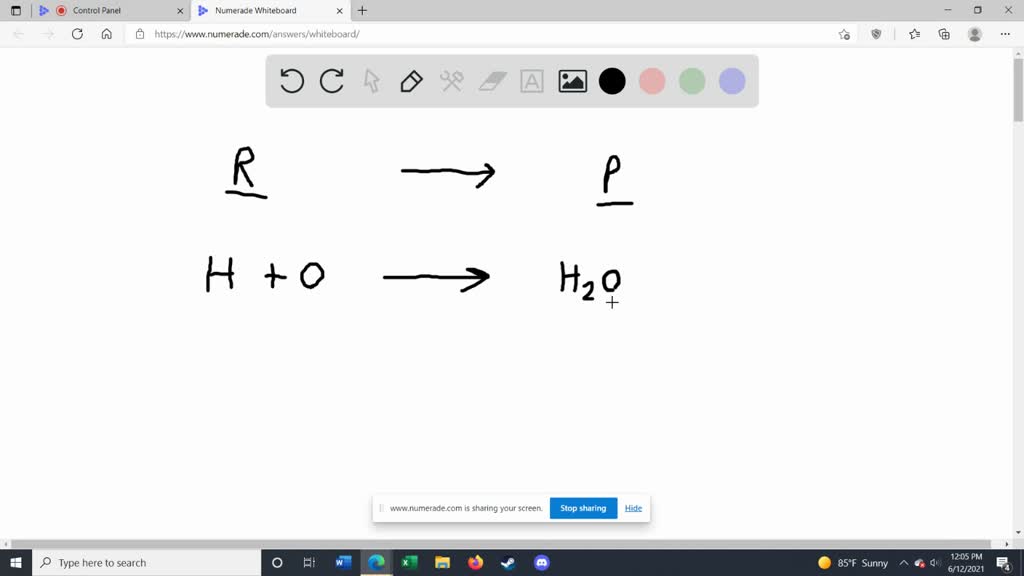












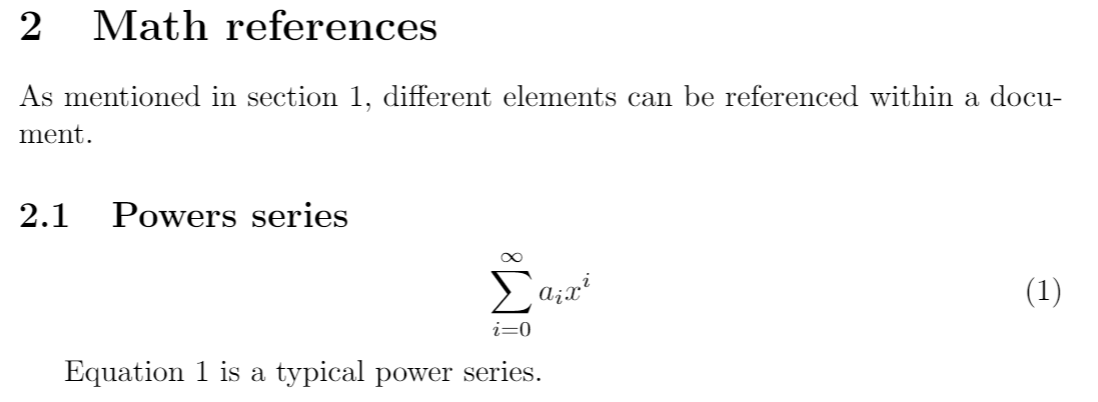
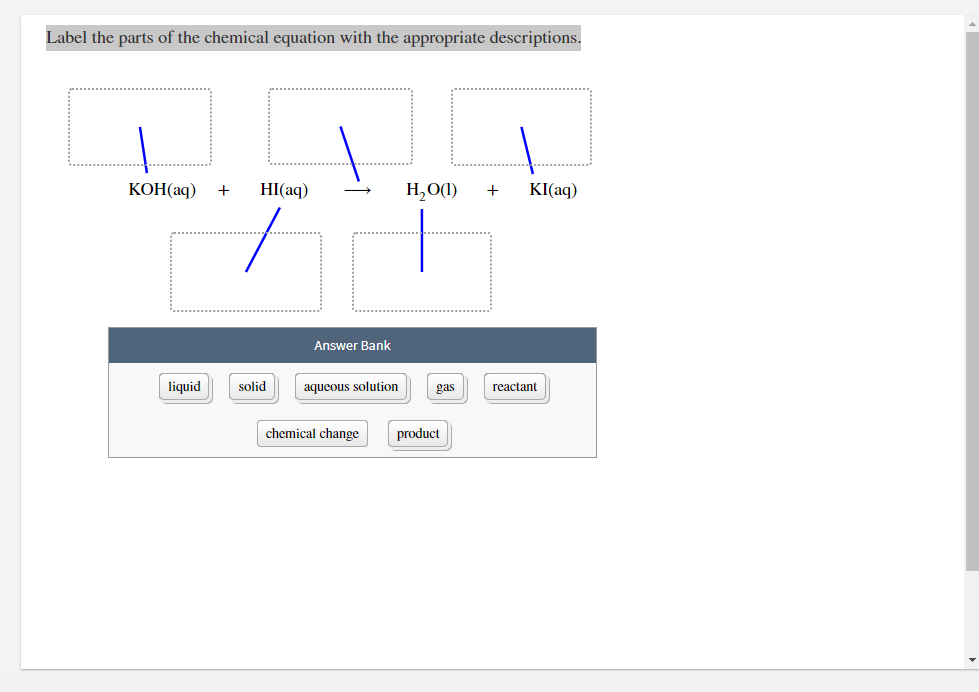
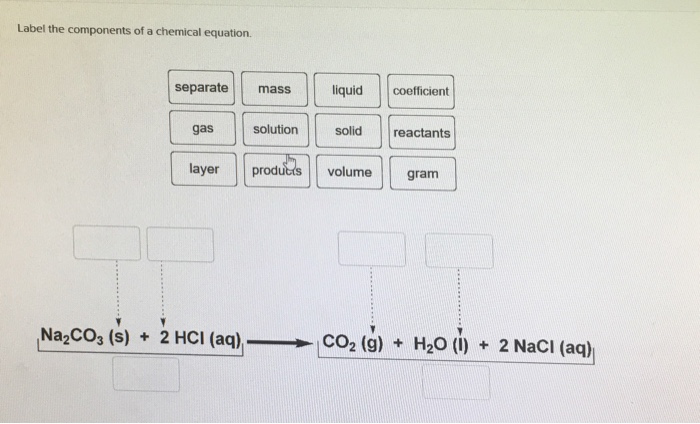







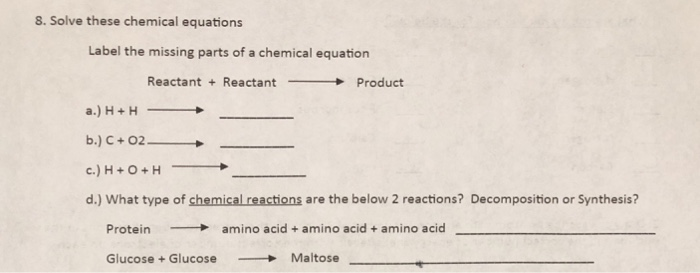






Post a Comment for "40 chemical equation label"